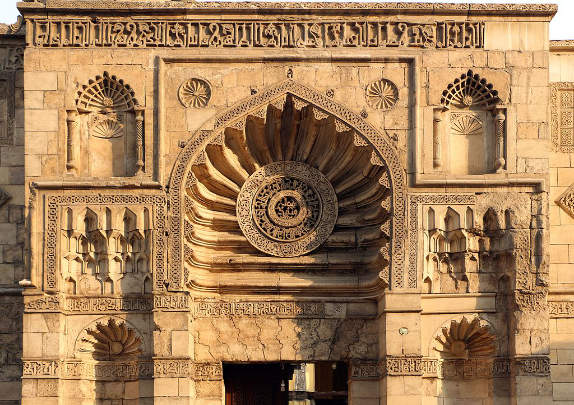
It is located in the Zabbaleen village at the base of the Mokattam cliffs. Simon the Tanner was a craftsman saint who lived during the 10th century and the cave church that was dedicated to him seems as though it might last for 10 more. Using a pre-existing cave and the slope that led into it, the current monastery seats 20,000 people around a central pulpit. Other nearby caves have also been built into separate church spaces and all of them have been linked to create a massive Christian complex in the heart of the Zabbaleen village.

The mosque was originally built as an enclosure by the Fatimid vizier Gawhar Al-Siqilli (c. 928–992), but was incorporated into the extended fortifications built by Badr al-Jamali. It consists of an irregular rectangle with four arcades surrounding the courtyard. An unusual feature is the monumental entrance with its projecting stone porch. It is located in Islamic Cairo, on the east side of Muizz Street, just south of Bab Al-Futuh. The most spectacular feature of the mosque are the minarets on either side of the facade, reminiscent of the propylon to a pharaonic temple.

Located in Coptic Cairo, it is situated in the eastern part of the Babylon Fortress and is one of the oldest buildings in Cairo, dating back to the 5th or 6th century AD. However, like many other buildings of Coptic architecture, it was rebuilt several times, most notably by the end of the 11th century. Her supposed relics rest in a small chapel left of the altar, along with a few other saints’ remains. The church houses some rare icons of St Barbara, the Virgin Mary and Jesus Christ. Beyond the church an iron gate leads to the peaceful Coptic cemetery.

The Aqsunqur Mosque (also known as the Blue Mosque or the Mosque of Ibrahim Agha) is located in Cairo, Egypt and is one of several "blue mosques" in the world. It is situated in the Tabbana Quarter in Islamic Cairo, between Bab Zuweila and the Citadel of Saladin. The Aqsunqur Mosque also serves as a funerary complex, containing the mausoleums of its founder Shams El-Din Aqsunqur, his sons, a number of children of the Bahri Mamluk sultan an-Nasir Muhammad and that of its principal restorer, Ibrahim Agha Mustahfizan.

The Ben Ezra Synagogue, sometimes referred to as El-Geniza Synagogue or the Synagogue of the Levantines (al-Shamiyin), is located in Old Cairo, Egypt. According to local folklore, it is in the place where baby Moses was found. This was the synagogue whose geniza or store room was found in the 19th century to contain a treasure of abandoned Hebrew, Aramaic and Judeo-Arabic secular and sacred manuscripts. The collection, known as the Cairo Geniza, was brought to Cambridge, England at the instigation of Solomon Schechter and is now divided between several academic libraries.

Al-Jam`e Al-ِAqmar, literally: Moonlight Mosque, also called Gray mosque, is a mosque in Cairo, Egypt dating from the Fatimid era. It is located on north Muizz Street. The mosque is notable for its façade, which is elaborately decorated with inscriptions and geometric carving. This is both the first mosque in Cairo to have such decoration, and it is also the first to have a façade which follows the line of the street, built at an angle to the rectangular hypostyle hall whose orientation is dictated by the qibla direction.
